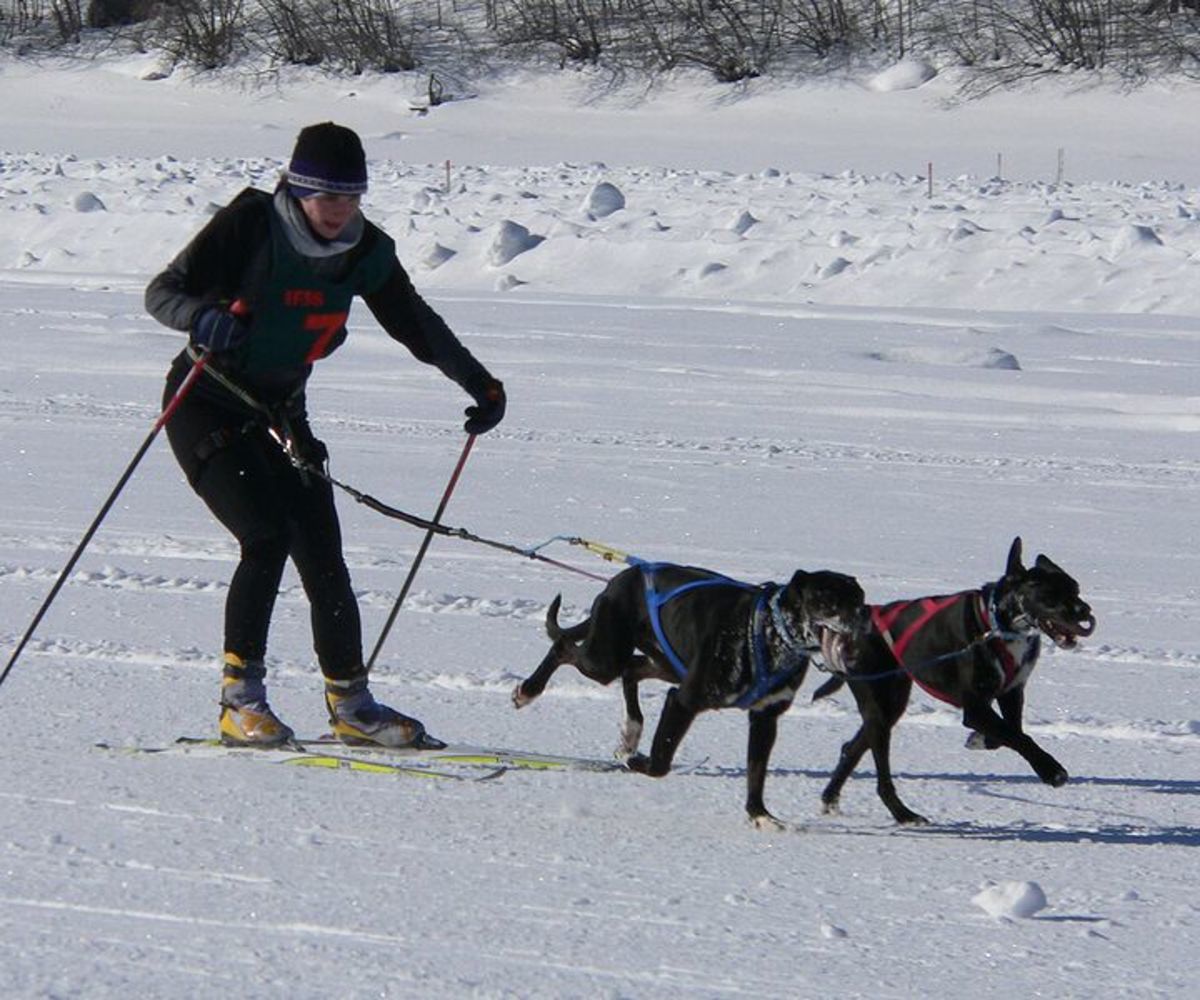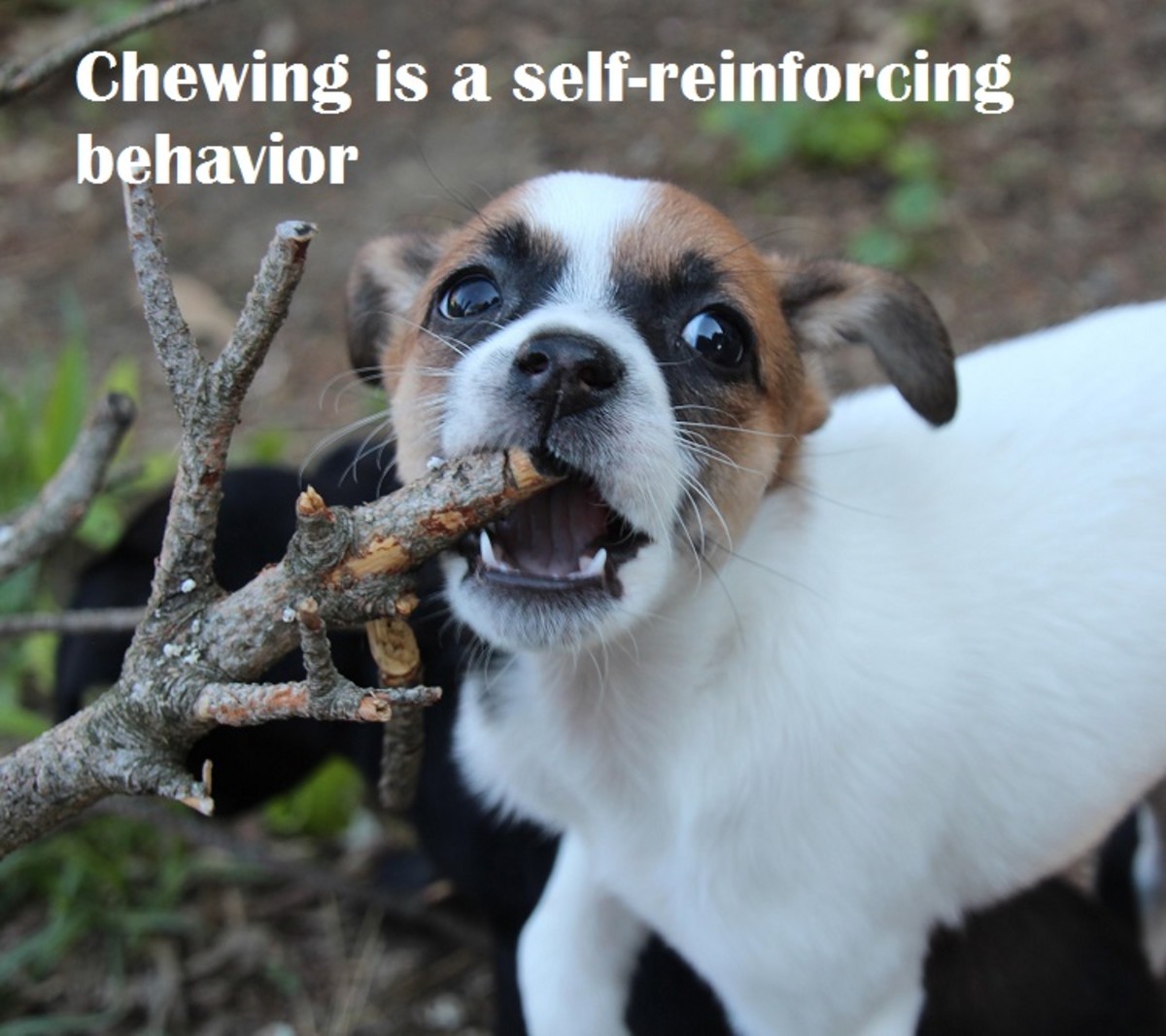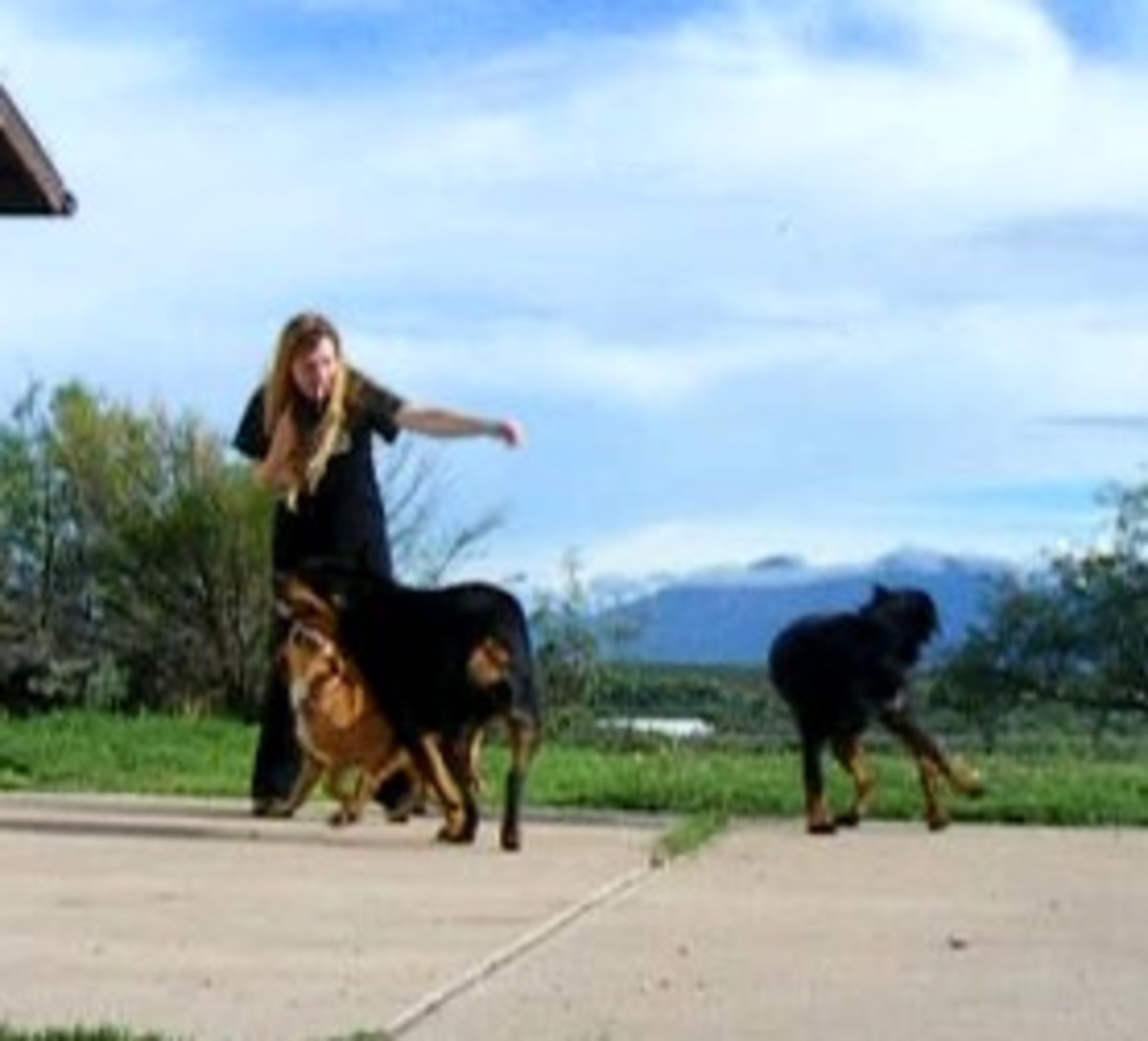- HubPages»
- Pets and Animals»
- Dogs & Dog Breeds»
- Dog Training
How I taught my adopted dog new tricks!
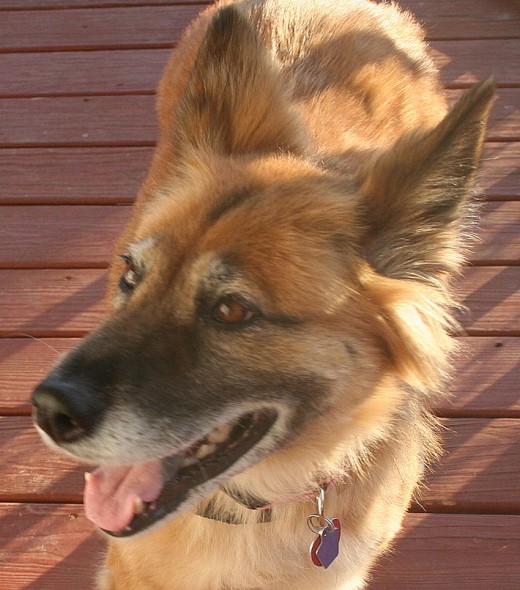
When I met Brownie!
I made the mistake of joining a social website and connecting with pages about animals.
Not that it was actually a "mistake". It was my mistake because I have a fond place in my heart for all animals, and let's just say it kept me very distracted.
One day while I was on the social site, I saw an animal shelter in my state advertising a homeless dog ready for adoption.
The shelter had so little hours to adopt the dog in some sort of virtual adopt-a-thon.
Two hours remained...no one adopted her.
One hour remained...no one adopted her.
By the last 15 minutes, I was on the edge of my seat calling the animal shelter begging for additional time! I was an hour away and couldn't get there fast enough but 15 minutes was just too little time.
Shame on me for not calling sooner. I honestly thought I hadn't a chance in the world as lovely as the dog was.
The animal shelter said, "come on down. We will hold the dog until you get here, but leave now if possible."
Within the next hour, I was on the road with two kids so excited they couldn't catch their breath.
Finally the moment arrived, and there she was.
Brownie was an older dog.
Benefits of adopting an older dog include:
- They come house broken.
- They already know some tricks.
- They are accustomed to being around people.
- They know not to chew things that aren't edible (such as the couch, furniture, toys, and your laundry).
- They are more calm and not as jumpy as younger dogs.
- They make great watch dogs.
- They take life at a slower pace.
- They sit down in long car rides.
Considerations before adopting an older dog:
- Older dogs have been around for a while but may not be as friendly as when they were younger. Dogs might develop aggression around smaller children. Dogs might become cranky and tired as they get older so if a more playful pup is what you desire, you may want to find a dog younger than 5 years old.
- Sometimes older dogs aren't as playful as younger dogs. Although I've met a 15-year-old toy poodle that will give any other a dog a workout chasing a stuffed toy!
- If you want a dog you can take to the park and play fetch with, an older dog may not be the right choice. They are more relaxed and mellow. Many times they'd rather sit this one out and just watch everyone else retrieve the ball.
- Older dogs are prone to arthritis, joint issues, hip issues, and fatigue. I knew an elderly Beagle that had congestive heart failure. It prevented him from taking long walks.
- Older dogs might become less tolerant of guests. If you have an active home where guests are coming and going, an older dog may not appreciate your social life as much as you. Older dogs love to sleep!
I personally love older dogs. But these considerations should be taken seriously before adopting an older dog because you want to make your dog as happy as possible. Not all dogs are a suitable match for all people.
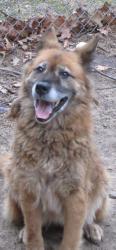
What to expect when adopting an older dog from an animal shelter.
If you adopt an older dog from an animal shelter, you won't find the dog in the same condition as you would from a private home or a rescue group.
Let me make myself clear as to what I mean by that.
When you adopt a dog from a private home, you will most likely be adopting a beloved pet that the owner can no longer care for.
When you adopt a dog from a rescue group, dogs are placed in loving foster homes and come to you in a well-cared-for condition. They are offered vet care before arriving at your home as well.
When you adopt a dog from an animal shelter, most shelters do not have the resources to care of a dog as a private owner would. Therefore, the dog might come to you unbathed or lacking medical care that the dog would have otherwise not been afforded had you not adopted him or her.
Older dogs are surrendered to animal shelters for various reasons. Sometimes dog owners want a younger dog who will be more playful and they bring their older dog to an animal shelter.
Other times, older dogs end up in animal shelters when something happens to their owners.
When I met Brownie, she needed a bath and a hair cut!
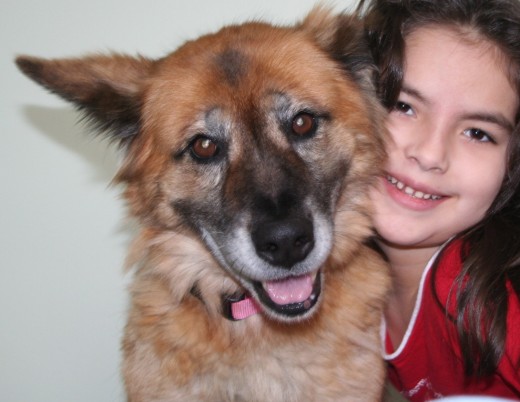
Gaining trust in your older dog.
Bringing Brownie home was the easy part.
Gaining her trust was another issue entirely.
Where did she come from? Who was her prior owner? What was her life like before I met her?
When you don't know the background and history of an adopted dog, you need to tread carefully to earn their trust.
Brownie came to us a mess from conditions out of her control. She needed a bath and some medicated shampoo from the vet's office.
Here are some suggestions for caring for an adopted pet after you get home:
- Make an appointment with a vet's office. If you are not an established patient for another pet, you'll need to make sure the office is taking new patients.
- I prefer to make an appointment for my pet before the adoption. That way there isn't a long wait time and you can usually get right in before bringing the pet home. (For instance, another adopter was getting a small dog as we were walking Brownie to the car. That adopter had already pre-scheduled the appointment with a vet next to the animal shelter! How brilliant it was of her to make the appointment for around the time of the adoption so she could get the dog checked out before bringing her home!)
- Once you get your new pet home, take care to bathe the dog. Sometimes it might take several times to get the dog's coat nice and clean. This will give you an opportunity to look over the dog and see if the dog has a good temperament around water.
- If you are equipped to do so yourself, look over the dog's nails and see if they need to be trimmed. However, if you feel any resistance or fear in the dog at your attempt to trim his or her nails, I wouldn't pursue that just yet. It can always be done safely in a vet's office.
- Talk to your dog.
- Take your dog for a walk and see what distance they can tolerate before getting tired. Some older dogs have difficulty walking downstairs.
- You can gauge how easy your dog will be to handle when you have them leashed on your first walk.
Walking two dogs together at a time takes patience and practice.
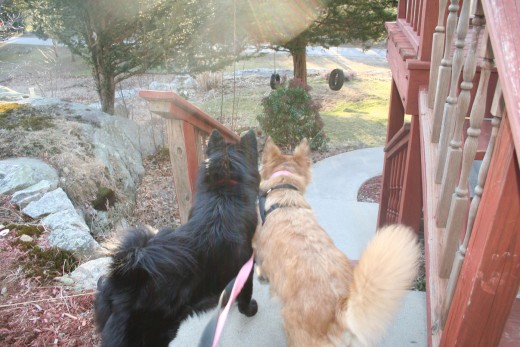
Consult with a dog behaviorist.
We consulted with a dog behaviorist. We have a pet-friendly home and we wanted everyone to get along well.
The dog behaviorist observed everyone in the house. He declared Brownie very tolerant around children. He was absolutely correct! She loves all children.
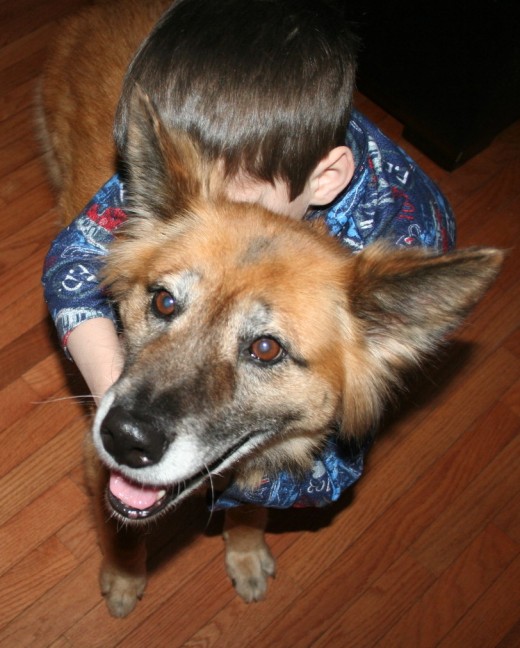
Be cautious with older dogs around children.
Fortunately, Brownie is very tolerant of all the hugs and in-your-face approach my children have around her.
But many times older dogs do not like this type of face-to-face contact.
Many times dog professionals will recommend adopting a young dog if you have a home with children. The dog will grow up with the child. Also, dogs are more playful when they are younger and will gladly engage in some safe rough-housing.
Older dogs like peace. They like their space, naps, and quietness. Chaos, disruption and loudness can cause anxiety in older dogs.
Brownie's first tricks.
It didn't appear that Brownie had ever been taught to play ball.
We spent hours in the yard every day teaching her to fetch a ball on a long leash. Brownie didn't play tug-of-war with the leash like some dogs like to do.
If you have a dog that seems to be more interested in chomping at the leash than fetching a ball, a chain leash might work best initially. The dog isn't inclined to chew on chain, except that I've also encountered dogs that will still try to chew the fabric leash handle!
The neighbors were impressed when we finally convinced Brownie to fetch the ball and run with it.
How to train your older adopted dog new tricks:
- Fetch. You can teach your dog how to fetch a ball. Start with a tennis ball. Take your dog on a long leash out in to your yard. Throw the ball no further than the length of the leash. Tell your dog to fetch or retrieve. If your dog doesn't respond, walk up to the ball. Show your dog the ball and throw it gently again. Say fetch. Do this several times. If your dog has no interest at all in the ball, use treats to motivate your dog. For instance, small pieces of cheese or dog treats will work. (I wear an apron with pockets when I'm treat-training dogs.) Keeping a treat in one hand, throw the ball. The dog will soon pick up the scent of the treat. If the dog walks over the ball, clap and cheer. Give your dog the treat. After a while, the dog will learn to associate the ball with a treat and will fetch on his/her own!
- Shake. Some dogs do not like to have their paws touch. Especially if your older dog has arthritis issues, teaching them to shake paws might not be a good idea. Basically all you do is hold up their paw and shake it, then say the word shake. Again, if your dog doesn't respond, keep a treat in your hand and shake your dog's paw. Pretty soon you will have your dog begging for treats and willingly shaking for one!
- Walking with another dog. This can be really tricky. We were fortunate enough to have a dog similar to Brownie's size and height. They got along great. It was easy to leash them both up and walk them at the same time. People were actually amazed that we were able to do this on day one. There are some professionals who will say it's impossible sometimes to get two dogs to walk together on a leash. I recommend trying it with caution. If you observe any aggression or resistance, it's probably better to walk the dogs alone.
- Walking without a leash. There are leash laws in every state. Always observe the law when walking your pet because the last thing you want is to get yourself or your pet in trouble with animal control. However, I taught Brownie to walk herself and this is how I did!
Waiting for the command to eat her treat.
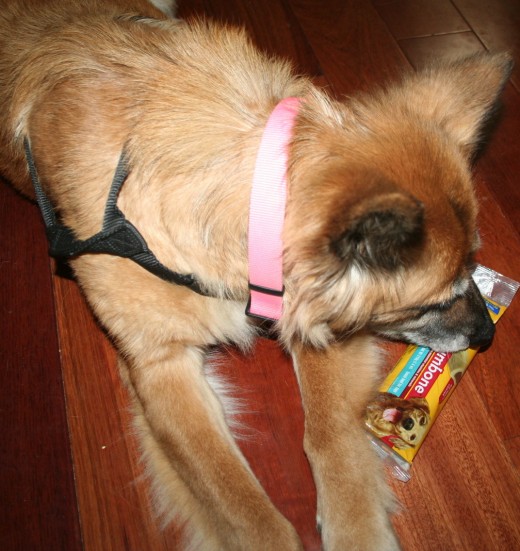
Treat training your dog.
Some dogs develop aggression toward food.
It's important to train your dog how to wait and be gentle around food.
Harnesses v. collars
A harness is a great way to get your dog used to walking by your side. It's easier on the dog's neck if they tend to pull the leash.
Sharing.
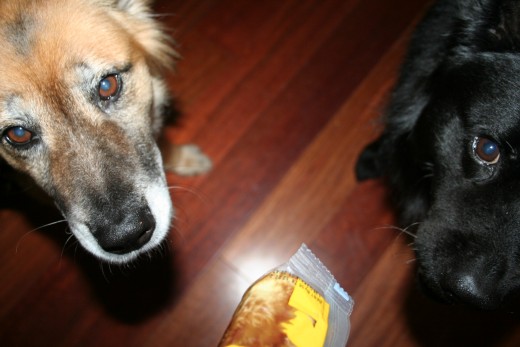
Sharing food.
Another problem that can arise in dogs, especially if there are multiple dogs in a household, is aggression toward other dogs when food is around.
Dogs that have trouble controlling themselves around food can escalate a fight by sending negative signals.
I talked with a vet once who said that he only feeds his dogs when they are all locked in kennels. He's afraid they will fight over the food.
It's also important to know that just because two or three dogs get along in your home just fine, sometimes when you introduce a new dog you can inadvertently stir up aggressive tendencies toward the newcomber if you try to feed everyone at the same time in the same room!
Being gentle.
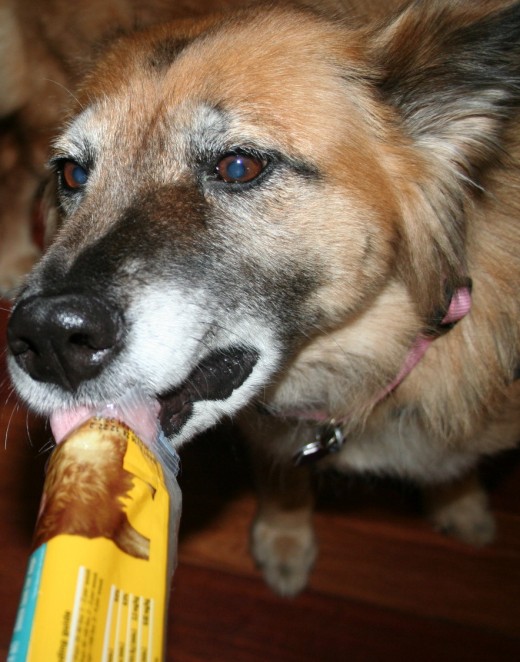
Teaching the command to be gentle.
Some dogs are just rough.
There are dogs who cannot take things gently out of your hands. This can pose a huge problem if the hand belongs to a child. You wouldn't want your dog to accidently bite or nip at a child's fingers while grabbing for a piece of food.
It's important to teach your dog manners! They can learn!
Older dogs can have issues with their teeth. Dental bones, fresh raw broccoli and carrots are good healthy chew things that act as teeth cleaners as well!
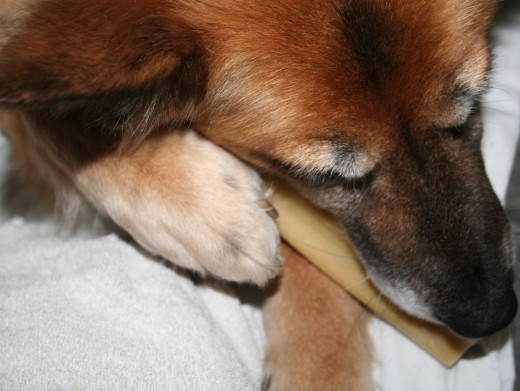
Brownie unleashed.
I was in the hospital in December 2012. I was paralyzed for 8 days. Having never had an issue walking before, this came on suddenly and without warning.
What was I to do? What about my dog? The first thing I told the doctors at the hospital was I needed to get home because others depend on me.
I was helpless.
When I arrived home from the hospital, I couldn't move my right leg normally for a few months. I had to go to physical therapy and use a walker to get around.
When I started walking with a cane, I decided it was time to start walking with Brownie again.
To be honest, I was afraid. How would I walk the dog without being tripped by her leash? How could I keep up with an injured leg? What would I do if she pulled me and I fell?
Sometimes, we advance through desperation in this life! I hope what I overcame and what I accomplished when all the odds were against is inspiring to all!
Dragging my leg one day, Brownie had to go out. I had no one home to help. I knew I had to let the dog outside. I was afraid that Brownie would run away. What if she ran in to the woods? Once fit and able, I was now handicapped and could barely take care of myself.
I told Brownie that I needed her help.
I honestly believe it was the trust I earned from Brownie by showing her how much I cared for her and how long I had worked with her.
That fateful day, I opened the back door. Brownie ran outside. I was devastated. All I accomplished was letting my dog escape! Great, wouldn't my husband just be pleased with that phone call!
But not so fast. Brownie walked around the yard, did her business, and came back home!
Training your dog to come home.
Training Brownie turned out to be an easy task. One I probably would have never attempted had I never been paralyzed!
Older dogs tend to be more home bodies. The secret to training Brownie was the fact that she loved being home!
If you think about it, Brownie came from an animal shelter. I have no idea where she was before that. From the day I adopted her, I started saying "Go Home Brownie" after our walks.
It was from that she learned home meant where she lived. Dogs are smart. They do listen even when we don't think they can hear us!
After a while, Go Home meant run back to the house where her loved ones pamper her and play with her. Go Home meant where to find her food and where to rest.
That fateful day I opened the back door and set Brownie free, I honestly thought I had made the dumbest mistake in my life.
I'm not saying that all dogs will learn so easily. I wouldn't suggest just letting your dog out the back door. Young dogs are too free-willed. They want to run fast. (Unless you have a fenced-in yard.)
Brownie goes out and comes back on her own.
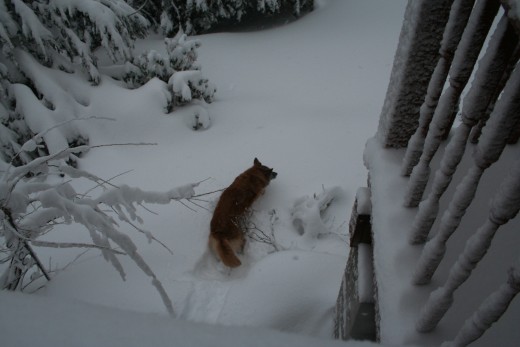
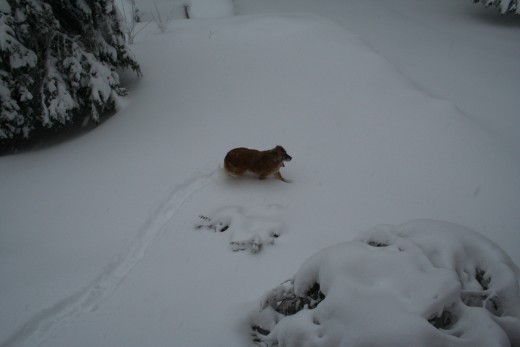
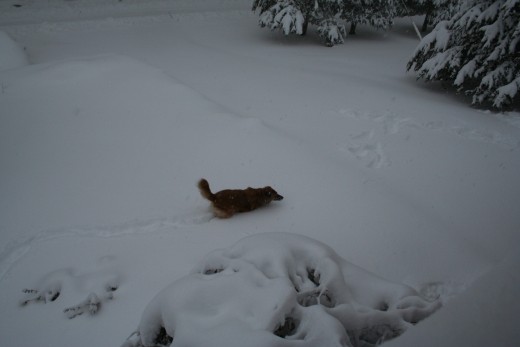
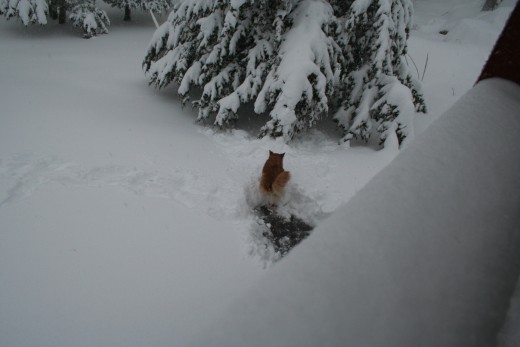
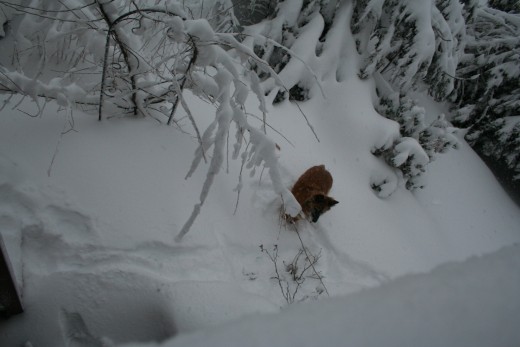
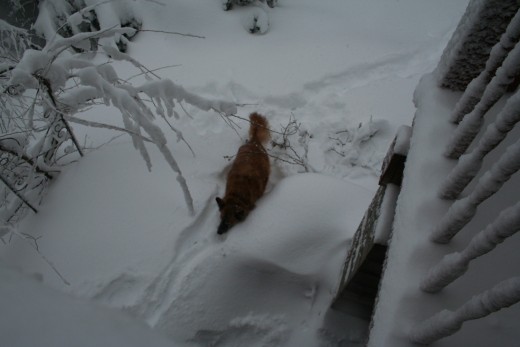
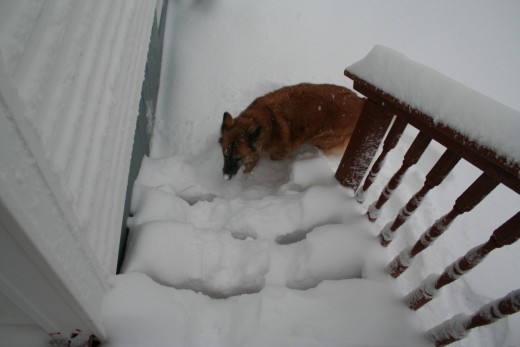
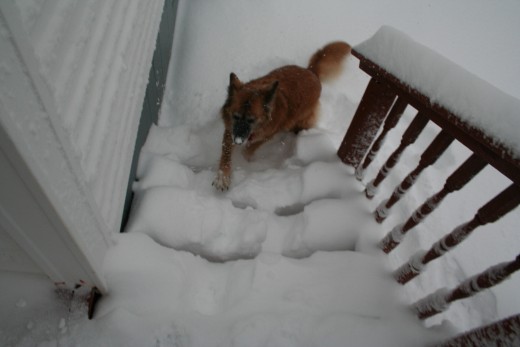
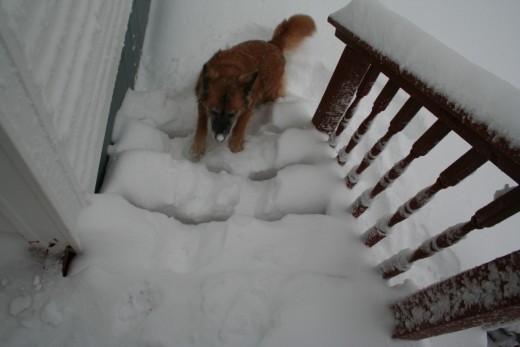
Conclusion
Training your dog can be such a rewarding experience. It really lifts us up to show off our accomplishments and know that it was the product of your effort that manifested in your dog's success.
Brownie paws at my leg when she needs to go out. I let her out while I sip sweet tea on the front porch. She does her business and comes home.
After all, home is where her heart is!

